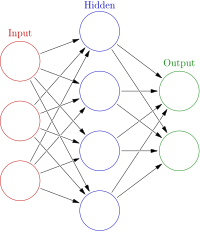
Photo from wikipedia
The problem addressed in this paper is the detection of drowsiness based on signals acquired using non-invasive and wearable sensors. A combination of signals from electroencephalography (EEG) electrodes, accelerometer, and… Click to show full abstract
The problem addressed in this paper is the detection of drowsiness based on signals acquired using non-invasive and wearable sensors. A combination of signals from electroencephalography (EEG) electrodes, accelerometer, and gyroscope is acquired through a commercially available off-the-shelf headband to achieve this goal. The aim is to substitute the use of intrusive sensors and cameras by extracting both physiological and behavioral features for drowsiness detection using a lightweight wearable headband. A dataset is acquired from 50 volunteers using the MUSE headband for both fresh and drowsy behavior in the resting state, where subjects stare at a slow moving object on a screen and no external stimuli is used. The drowsy state is induced by sleep deprivation. The data are labeled subjectively using the Karolinska sleepiness scale. Complementary features extracted from spectral signals, head movement, and blink analysis are combined to form a feature vector for classifiers to improve the robustness and detection accuracy of the system. The implemented system is validated on the data collected in fresh and drowsy states using a leave-one-out cross-subject and 25% hold-out level testing. A detection accuracy of 92% is achieved using selected features and a linear support vector machine classifier. The results show that the accuracy of drowsiness detection is improved by using a hybrid feature vector acquired from data using multiple sensors.
Journal Title: IEEE Sensors Journal
Year Published: 2019
Link to full text (if available)
Share on Social Media: Sign Up to like & get
recommendations!